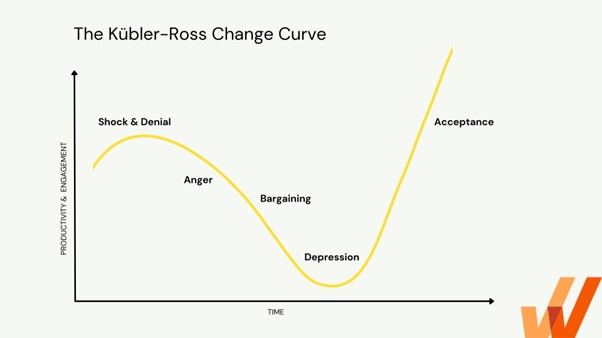
Organisation change and the impact on individuals within the business cannot be overlooked. As HR professionals and managers, it is important to acknowledge that some people embrace change whilst others will find it more challenging, and this can unsettle them.
If we look to business theory, the Kubler Ross Change Curve which is originally applied to the grief process can also be applied to change in the workplace. Managers and those leading change are able to use these theories to anticipate the range of feelings and emotions that employees may experience.

1. Denial
The first stage is shock or denial, and an individual puts forward their defense mechanisms to deflect the actual occurrence of the change. There is a steep decline in employee productivity in this stage, as it’s only human to cling to past processes or individual expectations, leading to a disconnect with reality.
2. Anger
When the reality of change sinks in, it’s manifested in the form of fear or anger. Any change initiative has the potential to spiral out of control in this stage, resulting in significant change failures.
For example, video marketing software company Wistia focused on aggressive business growth. Post its profitability, leaders went astray from company values, causing employee burnout & attrition. Instead of investing in the existing strategy and framework, the company hired aggressively, spent more on advertising, and consumed its current profits.
3. Bargaining
Once an individual crosses the anger stage of the change curve, they attempt to salvage the situation by exploring the path of least objection. They may try to negotiate and find a compromise.
4. Depression
In the depression stage, a person loses hope entirely. There are signs of extreme sadness, regret, and demotivation.
5. Acceptance
In the final stage of the change curve, individuals come to terms with the change. Their inhibitions are lowered, they accept the change, and start to explore new favourable opportunities that are a result of the change. Once employees accept the change, you must cement the change into your organisational culture to avoid reverting to old habits.
However, we feel it is important to recognise that these emotions are not always strictly chronological and often employees can and will bounce forwards and backwards between these emotions and this can be challenging for organisations where they have multiple individuals at different stages of the process. However, recognising this is the first step!
Please contact Blue Star HR for more information on change management if your company is undergoing major change.
(WhatFix.com, 2022)



